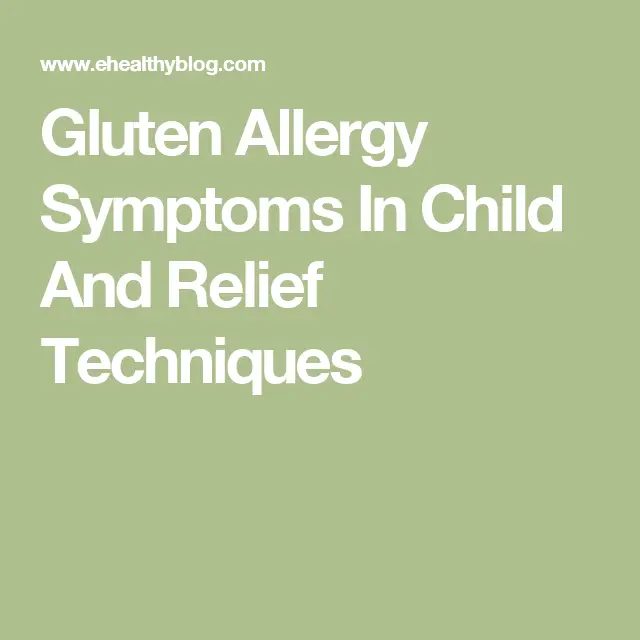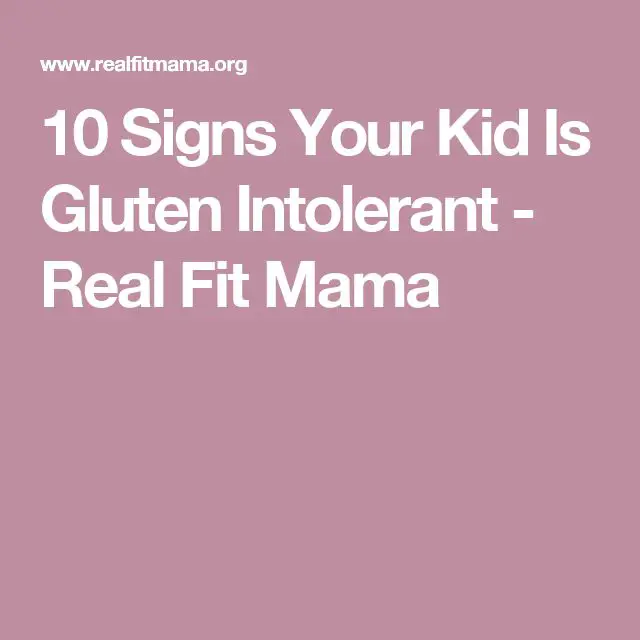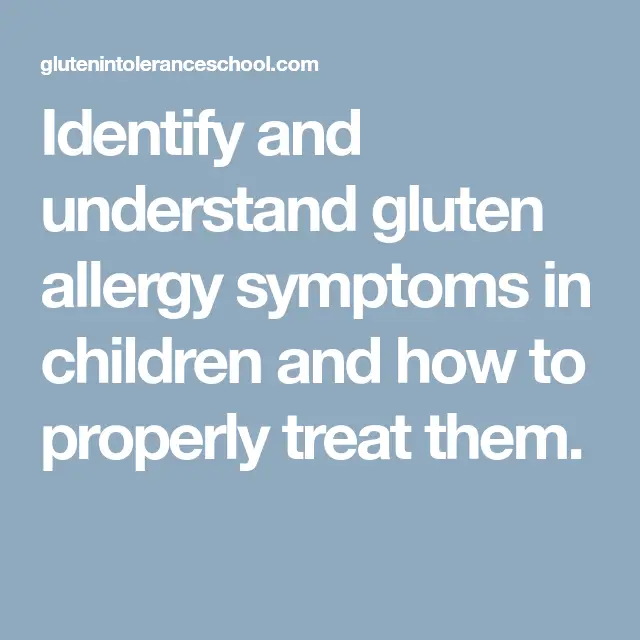What Are The Symptoms Of A Gluten Intolerance And Wheat Allergy
A child with an intolerance to gluten or wheat allergy may experience many of the same symptoms as someone with celiac disease, making it difficult to distinguish between them without a blood test. The main difference, however, is that a person with a gluten intolerance or wheat allergy will likely experience symptoms that are less gastrointestinal in nature, and symptoms appear minutes to days after eating food that contains gluten. Some of the most common symptoms of a gluten intolerance or wheat allergy in kids include:
How Is Celiac Disease Treated
Celiac disease is treated by not eating gluten. This can be hard because gluten is in many foods, but a dietitian can help adjust someone’s diet to cut out gluten. It is important not to start a gluten-free diet unless you are truly diagnosed with celiac disease.
Following a gluten-free diet allows the small intestine to heal. But that doesn’t mean the person can start eating gluten again. For someone with celiac disease, gluten will always irritate the intestines and, if this happens, the diarrhea, belly pain, and other problems will return.
If you’re diagnosed with celiac disease, it can be a challenge to learn which foods contain gluten. You may not be able to remember them all, but you can keep a list with you and ask about menu items at restaurants before digging in. Before you know it, you’ll be a pro at knowing which foods are safe and which are not.
What Are The Symptoms Of Wheat Allergy
Immediate reactions occur within minutes of exposure and include an itchy rash , swelling, vomiting, diarrhoea, runny nose, and itchy eyes. Severe reactions are much less common but can include difficulty in breathing , feeling faint or dizzy. Some people develop symptoms with wheat only after vigorous exercise .
Delayed reactions occur several hours after eating the food and include tummy pain, vomiting, diarrhoea and worsening of eczema.
Coeliac disease or gluten intolerance is a delayed reaction to wheat. People with Coeliac disease do not get hives or breathing difficulties but can have belly aches, diarrhoea or generally feeling run down.
Recommended Reading: Are Mike’s Hard Lemonade Gluten Free
Gluten Allergy Symptoms In Children
If you are parent or doctor, you need to understand how gluten allergy symptoms in children are nothing to ignore. More and more children are being tested each year and the number of kids suffering from celiac disease and related gluten intolerance is growing. In this article well discuss the difference between celiac disease and gluten allergy symptoms. I will also provide you with a specific list of these symptoms to watch for in your child.
This Session Will Cover:

- Why testing for gluten is so complicated
- The use of rapid test kits, both by industry and individuals
- The interpretation of test results
- Why you might get a positive result with one kit and not another
- Hot spots and the averaging of test results
- Challenges with taking samples from whole grains
- GFCO testing overview
Read Also: Are Blue Diamond Almonds Gluten Free
When Should I Call My Doctor
Some symptoms of gluten exposure can be severe. Seek medical attention if you experience diarrhea or vomiting. Dehydration can lead to dangerous electrolyte imbalances.
A note from Cleveland Clinic
Gluten intolerance may make you feel sick after eating gluten. You might get bloated, nauseous or gassy. Gluten intolerance causes a lot of the same symptoms as celiac disease, but its not the same condition. Celiac disease is an autoimmune disorder that leads to damage to the digestive tract. People with gluten intolerance usually find relief from their symptoms by following a gluten-free diet. Gluten-free diets do have some health risks. Its important to work with your healthcare provider and a dietitian to build the right treatment plan for your needs.
What Causes A Food Intolerance
It is often unclear why a person is sensitive to certain foods.
If your symptoms happen after eating dairy products, its possible you may have lactose intolerance. This means your body cannot digest lactose, a natural sugar found in milk, yoghurt and soft cheeses. A GP can usually diagnose lactose intolerance by looking at your symptoms and medical history.
Some people have trouble digesting wheat and experience bloating, wind, diarrhoea, being sick and stomach pain after eating bread. Read more about wheat intolerance .
Otherwise, the culprit may be a food additive, chemical or contaminant, such as:
- monosodium glutamate
- toxins, viruses, bacteria or parasites that have contaminated food
- artificial food colours, preservatives or flavour enhancers
You May Like: Symptoms If Your Allergic To Gluten
Older Children And Teens
Older children and teenagers may have symptoms or concerning signs that are not obviously related to the intestinal tract, which are called extra intestinal or atypical symptoms.
These symptoms are what may convince a physician to test for celiac disease. Some of these manifestations include:
- Achy pain in the bones or joints
- Chronic fatigue
- Itchy skin rash
- Recurring mouth sores, called aphthous ulcers, which look like canker sores
Adolescents with celiac disease may also have mood disorders, including anxiety and depression, as well as panic attacks.
Discuss Your Childs Gluten Allergy Symptoms With Your Doctor
As with any serious medical condition, its a good idea to discuss your concerns with your family physician as soon as possible. While researching celiac disease, gluten allergies and gluten intolerance online can help you determine whether or not you have cause for concern, only a qualified doctor can make a true diagnosis. In addition to diagnosing the underlying problem your physician can be a great resource for treatment options. It may at first seem like a difficult journey when you realize you must raise children with celiac disease or face gluten intolerance in children you dont need to go it alone.
Read Also: Gluten Free Angel Food Cake
How Is Celiac Disease Diagnosed
EF: The first step is to do a blood test to check for an antibody called tissue transglutaminase IgA, or tTG-IgA. If the results show an elevated tTG-IgA level, thats a red flag that your child may have celiac disease.
A gastroenterologist will confirm the diagnosis using an endoscopy . They will obtain a biopsy of the intestine to see if there are any signs of celiac disease.
Read: Tummy Trouble Tips
What Causes Gluten Intolerance
The exact causes of gluten intolerance arent well understood. Some research shows that people may not be sensitive to gluten, but to a certain carbohydrate found in many foods. Their bodies dont absorb the carbohydrate as they should. It stays in their guts and ferments, causing sickness.
Other research suggests that wheat might affect the lining of some peoples digestive tracts. This lining usually keeps bacteria from leaking out of your intestines. But in people with a gluten intolerance, the lining may not work as it should, allowing bacteria into their blood or liver and causing inflammation.
You May Like: Dunkin Donuts Hash Browns Gluten Free
What To Know About Celiac Disease In Children
Sep 14, 2022Koren Wetmore
The signs might be subtle: You notice your child seems to always get stomachaches after eating toast or pasta. Maybe your daughter has recurring bouts of constipation, or your son is growing much slower than his classmates.
You start to suspect that your child has something worth asking your pediatrician about. That something just might be celiac disease.
Celiac disease is caused by an abnormal immune response to glutena protein found in wheat, rye and barley. It damages the lining of the small intestine and makes it hard to absorb nutrients. As a result, children with celiac disease may not get the nourishment they need to grow and thrive.
The condition requires lifelong care. If left untreated, it can lead to delayed growth and even thin bones and fractures.
Celiac disease affects 1 in 300 children in the United States. That number rises to 1 in 10 for children with a parent or sibling who has the disease.
Its important to ensure your child gets all the calories and nutrients they need. Celiac disease damages the lining of the intestine, so your child may not be able to absorb certain key nutrients, such as iron.
Symptoms can appear in children as young as 6-9 months old, or whenever gluten-containing foods are introduced to a childs diet.
Sometimes the patients symptoms are significant and you know theres something wrong, says Erin Feldman, a pediatric dietitian with the Cedars-Sinai Pediatric Digestive Diseases Clinic.
What Is Gluten Sensitivity

Back to non-celiac gluten sensitivity. Since research into this condition is relatively new, not all physicians have accepted it as a real condition. Consequently, not all will give you a diagnosis of gluten sensitivity.
Those practitioners who will diagnose the condition will conduct celiac disease testing to rule out celiac first.
Still, recent medical research on gluten sensitivity has strengthened the theory that its a separate condition from celiac disease. Celiac is caused by your bodys reaction to the gluten protein found in wheat, barley, and rye.
Its less clear what exactly causes gluten sensitivity. Because it may be a non-gluten component of wheat and the other gluten grains, non-celiac wheat sensitivity may be a better name for it. For now, though, most medical researchers refer to the condition as non-celiac gluten sensitivity.
To get a better picture of the most common symptoms found in gluten sensitivity, Verywell Health spoke with three physician researchers who have spent a great deal of time studying the condition:
- Dr. Alessio Fasano
- Dr. Kenneth Fine
- Dr. Rodney Ford
They discussed their own clinical experience involving patients with gluten sensitivity. It should be noted that in some cases, their opinions havent been confirmed in published research or accepted by the medical community at large.
You May Like: Is Kraft Mayo With Olive Oil Gluten-free
Recommended Reading: Is Keto Food Gluten Free
Is Gluten Intolerance A Serious Health Concern
While it might be uncomfortable and require diet modifications, gluten intolerance is not detrimental to your childs health. It is manageable and treatable.
However, gluten intolerance can sometimes be confused with a more serious chronic condition known as celiac disorder. So its very important, if you believe your child is gluten sensitive, to talk with your pediatrician.
Your doctor can do two simple blood tests to check for celiac disorder, a chronic condition in which eating gluten triggers an immune response in the small intestine. Over time, this reaction damages the small intestines lining and prevents it from absorbing some nutrients .
If celiac disorder is ruled out, then your pediatrician should be able to help you adopt a holistic health plan to help your child manage their gluten sensitivity. This can include working with a nutritionist, making dietary changes, and lifestyle changes to help support your gluten sensitive childs health and wellness.
If you liked this article from Thrive Pediatrics, you might also like:
Gluten Intolerance Symptoms In Children
Karen writes cookbooks for people on gluten-free and dairy-free diets. Her goal is to create delicious recipes for people on restrictive diets so they can continue to eat delicious and nutritious foods without feeling deprived.
Learn about our Editorial Policy.
Terri is a critical care nurse with over 35 years of experience. She is also a freelance writer and author.
Learn about our Editorial Policy.
Gluten intolerance in children arising from wheat allergy, celiac disease, or non-celiac gluten sensitivity may be difficult to pin down. While there are some common symptoms indicating your child is gluten intolerant, there are others that are less common and therefore more difficult to connect to some form of gluten sensitivity.
Recommended Reading: Is Deli Meat Gluten Free
How Do You Manage Your Childs Gluten Sensitivity
Gluten intolerance can be managed by removing gluten from the childs diet. The child will no longer be able to eat bread products, any type of rye, any form of wheat, most pastas, or barley. Spelt must also be avoided. Keep in mind just because something is labeled wheat-free doesnt mean it is gluten-free. Unfortunately, you will often need to contact manufacturers directly to make certain some products dont somehow feature gluten in some subtle manner.
While it may seem difficult at first once you adapt to a gluten-free lifestyle it will become second nature and the good news is there are some great gluten-free alternatives for favorite childrens foods that traditionally contain gluten.
Thankfully, more and more grocery stores and manufacturers are improving their selection and labeling of gluten-free foods. There are also some great gluten-free recipes and cookbooks available. If you want to learn more about gluten-free flours and baking read my gluten-free pantry article: Gluten-Free Pantry
Once the gluten-free diet is started, the childs health should improve in some cases it can improve very quickly. When symptoms resolve, children with gluten intolerance can start to enjoy a better quality of life. In the near future, I will also include some ideas for helpful supplements and foods to help withe the recovery of gluten intolerance in children.
Gluten Allergy Intolerance & Celiac Disease
Intolerance to gluten protein can cause signs of a gluten allergy in two distinct disorders: celiac disease and gluten intolerance. Unfortunately, doctors often mistakenly dismiss gluten intolerance as having few consequences in the absence of frank celiac disease. Experts in the field of gluten intolerance, such as Dr. Stephen Wangen, have found that hundreds of health problems and signs of an allergy to gluten are connected to wheat and gluten reactions. About 10 percent of the population is reported to have some degree of gluten intolerance and about 30 million Americans are affected. This includes adults, children and toddlers.
Recommended Reading: Gluten Free Double Stuffed Oreos
You Consistently Have Joint Or Muscle Aches
Chronic joint or muscle pain is a common symptom reported in studies of non-celiac gluten sensitivity .
The pain is said to be like that of Fibromyalgia, a condition which may be improved by going gluten-free, at least anecdotally.
As joint and muscle pain is a broad symptom, only consider it a possible sign if you experience several of the other symptoms.
Dermatitis Herpetiformis: The Itchiest Rash Imaginable
It’s not unusual for a true allergic reaction to result in a skin rash, so it makes some intuitive sense to call dermatitis herpetiformis a “gluten allergy,” as it causes a remarkably itchy, persistent rash. But this rash is not the result of a true allergy: dermatitis herpetiformis is an autoimmune skin condition that occurs when you’ve eaten gluten grains. Symptoms include:
- Multiple small bumps that look like pimples
- Itching and burning
- Purple marks where bumps are healing
Dermatitis herpetiformis can occur anywhere on your body, but the most common locations for this rash are your buttocks, elbows, knees and on the back of your neck. If you’re about to have an outbreak, the itching usually starts even before you see the bumps appear. The condition is closely related to celiac disease and is associated with celiac disease.
Recommended Reading: Is Nothing Bundt Cakes Gluten Free
Considering Other Possible Causes Of Your Child’s Symptoms
Tips On How To Manage Gluten Intolerance In Children

Given that the only treatment for NCGS is a strict gluten-free diet, there are many challenges that may come up for a child. It is important that the child understands the situation and is able to navigate the diet in social situations. Talking about the diet in a simple way helps the child explain gluten intolerance to others more easily.
Here are some ideas to help to manage gluten intolerance in a child:
-
Speak with school staff or others who are going to prepare or oversee meals for your child so that menus can be adapted, and cross-contamination avoided.
-
Make sure teachers and caretakers understand what gluten intolerance is so they are not too anxious it is not like an allergy with the potential for anaphylactic shock but vigilant as children do not always eat what they are supposed to!
-
Find out if the childs classroom is going to use pasta or other gluten-containing foods in an arts and crafts activity, and provide a gluten-free alternative.
-
Think about what else your child may put in their mouth besides food. Some play dough contains gluten, for example.
-
Plan ahead so your child can have a fun gluten-free snack or sweet when their friends are having their treat.
-
Even better, organize it so that all children at a party enjoy something delicious and gluten-free.
-
Make sure your child is carrying some gluten-free emergency food for situations where gluten-containing food is served without any alternative option.
Recommended Reading: King Arthur Gluten Free Cake